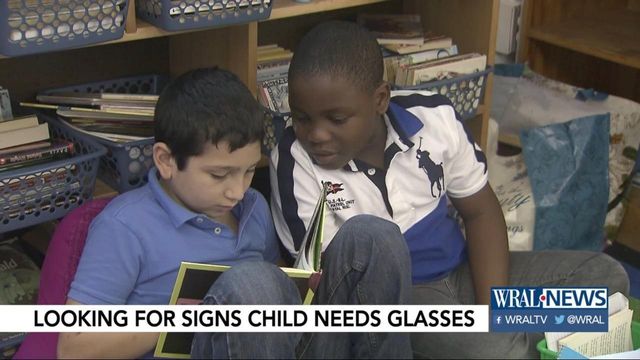Good vision is critical for learning: 4 tips to help ensure your kids' vision is crystal clear
After a summer of swimming and camps, it's time for kids to hunker down for another school year. But it will be hard for them to get those As when they can't follow along on the chalkboard - or, more likely, these days, the smart board - because they can't actually see what's on it.
Posted — UpdatedAfter a summer of swimming and camps, it's time for kids to hunker down for another school year. But it will be hard for them to get those As when they can't follow along on the chalkboard - or, more likely, these days, the smart board - because they can't actually see what's on it.
Get regular vision screenings
Babies' eyes are examined soon after they're born. Regular eye screenings begin during well child checkups at age 3 when kids can accurately describe the images or letters on an eye chart.
"They are able to identify pictures on a chart and are verbally going to give you feedback," Dr. Jordan said.
While many doctors still rely on those old-fashioned eye charts which, Dr. Jordan said, are still reliable in uncovering issues, a growing number are using photoscreening to diagnose young patients.
"I've seen more and more referrals where I do hear from families that they have been screened with the device," Dr. Jordan said.
Share your family eye-health history with doctors
Common eye conditions to be aware of include nearsightedness, crossed eye, also called strabismus, and lazy eye, also called amblyopia. If they aren't treated during childhood, they could cause permanent vision loss.
Still, Dr. Jordan said, visions problems don't always run in the family. So, even if both parents have never had to wear glasses, that doesn't mean their children's vision will be 20/20.
"It is important, but it’s not always a hard and fast rule that it will pass on to a child," he said.
Know the signs of eye problems
Especially in young children who aren't able to verbalize that they can't see well, it's important to look for the signs. They might include complaints of eyestrain or headaches. They also could be squinting when reading or playing, for instance, turning their head or closing one eye. They might be standing too close to the TV or whatever object they're trying to look at.
"Sometimes we'll see parents come in and their child has been screened at the pediatrician or daycare center and they'll say, "He sees the Cheerio on the floor. He seems fine,'" Dr. Jordan said. "But the problem is just in one eye and that's what the screening has picked up."
Other things to look out for: White or grayish-white coloring in the pupil, one eye that turns in or out, or eyes that don’t track in sync, according to the North Carolina Society of Eye Physicians and Surgeons.
Trouble reading also could signal a vision problem, especially if a child's performance in other subject areas is fine.
"Reading is the key one," he said. "If their performance seems to be fine in other non-reading subjects, but they lose interest or can't sustain reading."
Test their eyes
If you're worried your child may have some vision problems, Dr. Jordan shares this easy test, which you can do at home, but only if you know your own vision is 20/20.
As you walk down the street, look for a street sign in the distance. As soon as you can read the name of the street, ask your child to read it for you - or identify the letters. If they aren't able to to see the letters or words clearly, it's probably time to take them to the pediatrician or ophthalmologist for a closer look at their eyes.
• Credits
Copyright 2024 by Capitol Broadcasting Company. All rights reserved. This material may not be published, broadcast, rewritten or redistributed.





